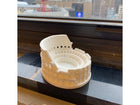Description
This comes in a SOLID color of your choice, the PLA Plastic material can easily be worked with if you'd like to hand paint details onto it. Pictures showing painted models are to show how a little paint can really bring these to life.
Comes in many colors and sizes! Fast shipping is guaranteed. This model is made from durable high strength plastic. If there is a color you'd like to see, or a color you'd like that isn't listed please feel free to inquire and we will get it done for you!
Welcome to Rome, Italy!
The Colosseum's original Latin name was Amphitheatrum Flavium, often anglicized as Flavian Amphitheatre.[11] The building was constructed by emperors of the Flavian dynasty, following the reign of Nero.[12] This name is still used in modern English, but generally the structure is better known as the Colosseum. In antiquity, Romans may have referred to the Colosseum by the unofficial name Amphitheatrum Caesareum (with Caesareum an adjective pertaining to the title Caesar), but this name may have been strictly poetic[13][14] as it was not exclusive to the Colosseum; Vespasian and Titus, builders of the Colosseum, also constructed an amphitheater of the same name in Puteoli (modern Pozzuoli).[15]
The name Colosseum is believed to be derived from a colossal statue of Nero that once stood nearby.[4] This statue was later remodeled by Nero's successors into the likeness of Helios (Sol) or Apollo, the sun god, by adding the appropriate solar crown. It was then commonly referred to as the "Colossus solis". Nero's head was also replaced several times with the heads of succeeding emperors. Despite its pagan links, the statue remained standing well into the medieval era and was credited with magical powers. It came to be seen as an iconic symbol of the permanence of Rome.
In the 8th century, an epigram attributed to the Venerable Bede celebrated the symbolic significance of the statue in a prophecy that is variously quoted: Quamdiu stat Colisæus, stat et Roma; quando cadet colisæus, cadet et Roma; quando cadet Roma, cadet et mundus ("as long as the Colossus stands, so shall Rome; when the Colossus falls, Rome shall fall; when Rome falls, so falls the world").[16] This is often mistranslated to refer to the Colosseum rather than the Colossus (as in, for instance, Byron's poem Childe Harold's Pilgrimage). However, at the time that the Pseudo-Bede wrote, the masculine noun coliseus was applied to the statue rather than to what was still known as the Flavian amphitheatre.
The Colossus did eventually fall, possibly being pulled down to reuse its bronze. By the year 1000 the name "Colosseum" had been coined to refer to the amphitheatre from the nearby "Colossus Solis".[17] The statue itself was largely forgotten and only its base survives, situated between the Colosseum and the nearby Temple of Venus and Roma.[18]
The name further evolved to Coliseum during the Middle Ages[citation needed]. In Italy, the amphitheatre is still known as il Colosseo, and other Romance languages have come to use similar forms such as Coloseumul (Romanian), le Colisée (French), el Coliseo (Spanish) and o Coliseu (Portuguese). via Wikipedia
Legal use under the Creative Commons - License
Free Shipping on all orders over $50
Materials: Plastic, LOVE.
















